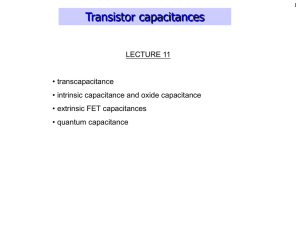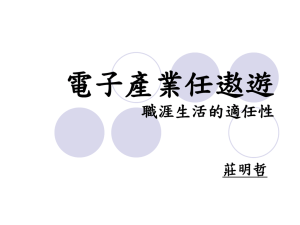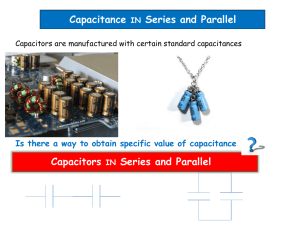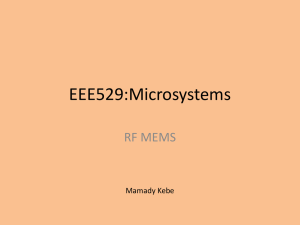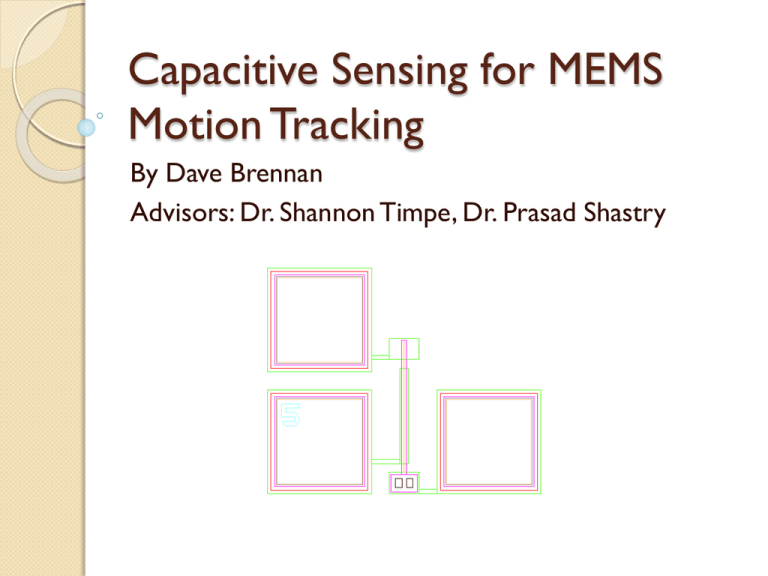
Capacitive Sensing for MEMS
Motion Tracking
By Dave Brennan
Advisors: Dr. Shannon Timpe, Dr. Prasad Shastry
Introduction
Part 1) Quick MEMS introduction
Part 2) Capacitive Sensing
Part 3) Goal
MEMS background
Microelectrical mechanical systems
(USA), Microsystems Technology
(Europe), Micromachines, Japan…etc
MEMS are in the micro-meters range
Arranged hundreds on a small cm by
cm chip typically
MEMS background
Manufactured by various etching
techniques
Silicon based technology
MEMS applications
Sensors such as to sense collisions for air
bag deployment
Bio MEMS similar to the Bradley MEMS
project
Inkjet printers
Bradley Bio MEMS Project
Main purpose is to analyze plant samples
for medical applications
Chip can be targeted with a specific
receptor, such that a plant bonding with
the chip alerts us of possible biomedical
applications of that plant
Electrical Engineering component is
capacitive sensing
Capacitive sensing
Useful to solve for an unknown mass (of
plant sample) after it is adsorbed on the
MEMS chip
Very small scale (atto farads = 10^-18,
smaller than parasitic capacitance in most
devices EE’s typically use)
Useful equations
Where k is beam stiffness, wn is
natural frequency in rad hz, m is
mass in kg
C is capacitance (F),
epsilon is permittivity of
free space constant, A is
area in meters^2, d is
distance in meters
Capacitive Sensing
Measuring capacitance
Two main ways to measure capacitance
◦ Change in area over time
◦ Change in distance over time
Cantilever beam capacitance
We can find the oscillation distance by
measuring capacitance by:
C
C
C
A
d d
A
d d
C
A
d w( x, y)
p
C
p
MEMS basic cantilever design
MEMS device with non constant
area
Sample capacitance values for a
fixed distance (at rest)
Sample of 4 different MEMS devices each
with a different capacitance
Initial tests
Set up an RC circuit with 10pF capacitor
(smallest in lab)
Parasitic capacitance on breadboard
warped data greatly
Fixed by using vector board thanks to Mr.
Gutschlag’s suggestion
Cut down leads on capacitor/resistor to
minimize error
Initial tests
Used system ID to identify the capacitor
based on RC time constant
Compared capacitor value found with
system ID vs measured on LCR meter
~20% error
Initial tests
Currently modeling probe capacitance
and resistance, reattempting system ID
experiment ASAP with probe model
included
Will this work for smaller capacitors?
Instrumentation
Andeen-Hagerling 2700A Bridge can
measure down in aF range
$30,000+
Not realistic for this project
Agilent LCM in Jobst can only measure
down to ~.1pF range
Instrumentation
Will explore the possibility of creating a bridge circuit
for measuring capacitance
Eliminating error
Ideally, want to measure capacitance as
accurate as possible, however settle for
5% error
Parasitic capacitance is approximately
desired capacitance in magnitude, this will
skew results highly
Eliminating error
Eliminating error
Since Cv is adjustable, “tune” out the
parasitic capacitance
Goals
Minimize the error of all calculations by
doing multiple trials
Learn about MEMS topology
Learn about capacitive sensing methods
If time permits, add a control system that
monitors the maximum peak of the
voltage wave and adjusts the frequency of
the applied voltage signal to ensure the
peak is always known
Goals
Learn how to use the probe station to
make connections to a MEMS chip
Learn how to accurately measure and
verify capacitance of the selected MEMS
device(s)
Obtain the natural frequency of the
MEMS device
Accurately track the mass adsorbed by
the cantilever beam and have it verified
System inputs
System inputs are voltage wave (special
attention paid to the frequency)
Plant mass
System outputs
Oscillation distance
Capacitance
Natural frequency
Mass
Complete system
Voltage wave (AC)
MEMS chip
Oscillation distance
(found by
capacitance)
Frequency (Hz or
Rad/Hz) of Voltage
wave
Peak monitoring
system
Capacitance
Adjust frequency of
AC Voltage wave
Is capacitance
different?
Mass can now be
calculated if desired
Project Summary
By accurately measuring capacitance, we
can determine the natural frequency of
various MEMS chips
The natural frequency will be at the peak
of the oscillation distance
Oscillation distance can be found through
capacitance
Project Summary
This will allow us to determine the mass
of the plant sample adsorbed
Once mass is verified externally,
possibilities are endless
References
Baltes, Henry, Oliver Brand, G. K. Fedder, C. Hierold, Jan G. Korvink,
and O. Tabata. Enabling Technology for MEMS and Nanodevices.
Weinheim: Wiley-VCH, 2004. Print.
Elwenspoek, Miko, and Remco Wiegerink. Mechanical Microsensors
with 235 Figures. Berlin: Springer, 2001. Print.
Timpe, Shannon J., and Brian J. Doyle. Design and Functionalization of
a Microscale Biosensor for Natural Product Drug Discovery. Tech. Print.
Questions?

